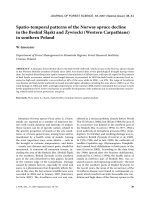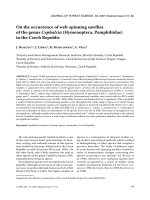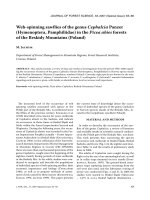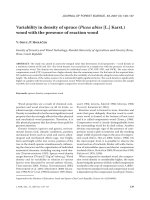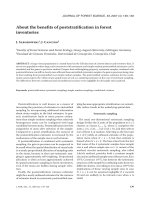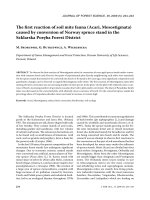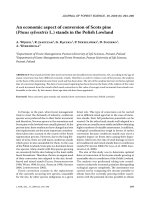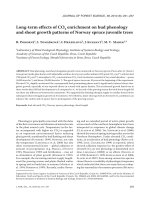Báo cáo lâm nghiệp: "PAR conversion efficiencies of a tropical rain forest" docx
Bạn đang xem bản rút gọn của tài liệu. Xem và tải ngay bản đầy đủ của tài liệu tại đây (154.51 KB, 3 trang )
PAR
conversion
efficiencies of
a
tropical
rain
forest
R.J.
Luxmoore
1
J.G.
Saldarriaga
2
1
Environmental
Sciences
Division,
Oak
Ridge
National
Laboratory,
Oak
Ridge,
TN,
U.S.A.,
and
2
Tropenbos
Program,
Bogoti,
Colombia
Introduction
The
mean
annual
quantities
of
photosyn-
thetically
active
radiation
(PAR)
absorbed
during
various
stages
of
regeneration
of
a
tropical
rain
forest
in
the
upper
Rio
Negro
region
of
Colombia
and
Venezuela
were
estimated
for
the
intervals
between
clear-
cut
and
1,
3, 10,
20, 35, 60,
80,
and
200
yr
of
growth.
The
forest
phytomass
and
litter-
fall
at
each
stage
were
obtained
from
pre-
vious
studies,
and
the
data
were
used
to
calculate
the
mean
annual
quantity
of
net
dry
matter
production
per
unit
of
absorbed
PAR,
the
PAR
conversion
efficiency.
Methods
The
basic
equation
for
the
calculation
is
given
by:
Total
dry
matter
=
PAR
conversion
x
Absorbed
(1 )
production
efficiency
PAR
(g
’
m-
2’
yr
1)
(g
’
MJ-
1)
(MJ
’
m-
2’
yr
1)
Saldarriaga
et
al.
(1986)
investigated
forest
succession
at
23
sites
representing
a
chronose-
quence
ranging
from
recently
abandoned
areas
after
slash-and-burn
agriculture
to
mature
rain
forest.
Aboveground
and
belowground
living
phytomass,
litter
and
root
production,
standing
dead
mass,
and
leaf
area
indices
were
estimat-
ed
with
allometric
regression
relationships
using
diameter,
height,
dry
weight
and
wood
density
data
from
each
of
the
23
sites.
Recently
avail-
able
data
for
1
and
3
yr
regrowth
forest
stands
were
also
included
in
this
analysis.
Regression
equations
for
converting
leaf
phy-
tomass
to
leaf
area
were
used
with
number
of
trees
per
hectare
(Saldarriaga
et
aL,
1986)
to
derive
leaf
area
index
(LAI)
values
for
the
forest
stands.
The
value
of
LAI
for
the
1-3
yr
period
was
3.9,
and
this
increased
up
to
a
mean
value
of
6.7
for
the
oldest
stand
(80-200
yr).
Results
The
annual
quantities
of
PAR
absorbed
by
the
forest
stands
(Table
I)
were
calculated
from
the
Bouguer-Lambert
(Beers)
Law
using
appropriate
LAI
values
with
an
extinction
coefficient
for
PAR
of
0.74
and
an
annual
net
incoming
PAR
of
2.75
GJ-m-2!yrl.
This
latter
value
was
ob-
tained
from
the
mean
annual
solar
radia-
tion
(5.2
GJ
’
m-
2’
yr
1)
measured
in
the
area
since
1971,
by
using
a
factor
of
0.55
for
the
proportion
of
PAR
(Stigter
and
Musabilha,
1982)
and
a
PAR
albedo
of
0.04
(Dickinson,
1983).
Dry
matter
production
for
the
8
growth
periods
(Fig. 1)
shows
the
highest
rates
during
the
first
10
yr.
A
significant
change
stand
structure
occurs
at
about
60-80
yr
with
the
replacement
of
several
early
successional
species
by
the
mature
stand
species.
This
results
in
no
increment
in
the
living
phytomass.
The
PAR
conversion
efficiencies
deter-
mined
from
eqn
1
show
the
highest
values
in
the
first
year,
decreasing
to
zero
by
year
70
(Fig.
2).
When
above-
and
below-
ground
production
is
combined
with
litter-
fall
(net
primary
production),
the
PAR
conversion
efficiencies
are
much
higher
for
years
20-140.
Discussion
and
Conclusion
The
PAR
conversion
efficiency
values
for
aboveground
growth
are
very
much
lower
than
the
1.7
g-MJ-
1
reported
by
Linder
(1985)
for
several
temperate
forests;
however,
the
results
are
consistent
with
the
low-end
values
in
the
0.2-1.0
g-MJ-
1
range
of
PAR
energy
conversion
values
derived
from
Jordan
(1971)
for
17
forest
types,
including
temperate
and
tropical
ecosystems.
The
analysis
by
Jordan
in-
cluded
coarse
roots
in
the
dry
matter
pro-
duction.
A
value
of
20
kJ!g-1
for
the
heat
of
combustion
of
dry
matter,
as
suggested
by
Leith
(1968),
was
used
in
the
conver-
sion
of
Jordan’s
values
from
an
energy
to
a
mass
basis.
This
analysis
shows
that
PAR
conver-
sion
efficiency
decreases
with
the
in-
crease
in
successional
stage
and
that
ef-
ficiency
values
are
generally
low
in
comparison
with
data
for
temperate
forests.
One
implication
for
agroforestry
in
tropical
areas
similar
to
the
upper
Rio
Negro
valley
is
that
short
rotation
times
(<10
yr)
are
desirable
so
that
relatively
high
energy
conversion
into
aboveground
phytomass
can
be
obtained.
Acknowledgments
The
authors
thank
the
staff
of
the
Ministry
of
Environment
at
San
Carlos
de
Rio
Negro,
Venezuela,
for
providing
solar
radiation
data.
Research
was
sponsored
in
part
by
the
Na-
tional
Science
Foundation’s
Ecosystem
Studies
Program
under
Interagency
Agreement
no.
BSR-831585
with
the
U.S.
Department
of
Ener-
gy
and
in
part
by
the
Carbon
Dioxide
Research
Division,
Office
of
Basic
Energy
Sciences,
U.S.
Department
of
Energy,
under
contract
DE-
AC05-840R21400
with
Martin
Marietta
Energy
Systems,
Inc.
The
research
is
a
contribution
to
the
Solar
Conversion
Project
of
the
Interna-
tional
Union
of
Forestry
Research
Organiza-
tions.
Publication
no.
3182,
Environmental
Sciences
Division,
ORNL.
References
Dickinson
R.E.
(1983)
Land
surface
processes
and
climate -
surface
albedos
and
energy
balance.
Adv.
Geophys.
25,
305-355
Jordan
C.F.
(1971)
Productivity
of
tropical
forest
and
its
relations
to
a
world
pattern
of
energy
storage.
J.
Ecol.
59, 127-142
Leith
H.
(1968)
Calorific
values
of
biological
materials.
In:
UNESCO
Symposium
on
the
Functioning
of
Terrestrial
Ecosystems.
UNES-
CO,
Paris,
pp.
233-240
Linder
S.
(1985)
Potential
and
actual
production
in
Australian
forest
stands.
In:
Research
for
Forest
Management
(Landsberg
J.J.
&
Par-
sons
W.,
eds.),
CSIRO,
Melbourne,
pp.
11-34
Saldarriaga
J.G.,
West
D.C.
&
Tharp
M.L.
(1986)
Forest
succession
in
the
Upper
Rio
Negro
of
Colombia
and
Venezuela.
ORNL/TM-
9712.
Oak
Ridge
National
Laboratory,
Oak
Ridge, TN, pp.164
Stigter
C.J.
&
Musabilha
V.M.M.
(1982)
The
conservative
ratio
of
photosynthetically
active
to
total
radiation
in
the
tropics.
J.
Appl.
Ecol.
19,
853-858
Uhl
C.
(1987)
Factors
controlling
succession
following
slash-and-burn
agriculture
in
Amazo-
nia.
J.
Ecol.
75,
377-407

